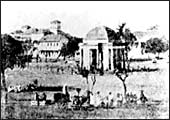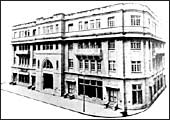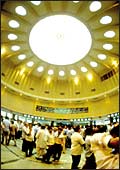|
A
big bull broker discretely doling out tips on hot buys, investors
either making a killing or losing their shirts, an occasional
financial scandal, even a bomb blast-sound familiar? Yes, we're
talking about the Bombay Stock Exchange (BSE), but not in its
present 28-storey, two-faced tower avatar. Rather, all these proverbial
elements first played themselves out over a century ago at the
BSE-which completed 131 years last fortnight-the most glaring
difference, of course, being that brokers didn't sit behind trading
terminals, but under a banyan tree at Bombay Greens in the 1850s.
(That tree still stands in Horniman Circle, a stone's throw away
from the BSE building).
The Big Bull of those early years was one
Premchand Roychand, who led a group of brokers under the umbrella
of The Native Share and Stockbrokers Association. By 1875, this
motley bunch formalised their association, which came to be known
as the Bombay Stock Exchange. And thus was born the oldest stock
exchange in Asia.
|
|
 |
 |
| BSE through the ages: (clockwise from
above) In 1993, brokers transacting at Bombay Greens in 1840,
and the old BSE building |
Roychand, who was also known as the Cotton
King in those days, pretty much controlled the markets then and
was also responsible for setting the rules and regulations governing
the exchange, some of which are in practice even today. Some of
the earliest stocks that traded on the BSE were Mazgaon Land Reclamation,
Back Bay and Port Canning shares that, thanks to the American
Civil War from 1861-1865, did really well. These were trading
at huge premiums (the Mazgaon Land Reclamation share traded at
a Rs 9,000 premium for some time) and business worth crores was
done daily, almost all of it pure speculation. But this lasted
only till the end of the Civil War. July 1, 1865 goes down in
history as probably the first black day for the markets-hundreds
of contracts (called 'time bargains') matured but couldn't be
honoured by buyers and sellers alike. The result was a crash,
the first of many to come.
For a long time, brokers conducted their business
informally, out in the open, on the steps of the nearby banks.
But the banks soon started objecting to this as they felt it was
affecting their business. It was only after this that the Sir
Dinshaw Petit Native brokers hall was built, which was inaugurated
on January 18, 1899. The membership fee started as low as Rs 15,
and has been regularly hiked over the years.
Over the years, the BSE has grown in importance,
getting increasingly linked with the overall environment in the
country. Subsequently, there were slumps brought on by wars, fall
of exchange rates, etc. On November 5, 1962, right after the Chinese
invasion, the markets went into a free fall and were closed indefinitely
for a week. To keep with the growing number of members, the then
Finance Minister Morarji Desai laid the foundation for a new building
on May 16, 1968.
Although the BSE had been around for over
a century, the BSE Sensitive Index or the Sensex as it's known,
came into being as late as January 1986. The main reason for this
was the lack of an indicator, which reflected the mood of the
market. Initially, it was calculated at the end of every trading
day, but with the BSE becoming computerised, it has since been
updated every few minutes. The way people trade has changed too-from
the open outcry system to a high tech computerised and organised
system.
What remains the same is a modern day Premchand
Roychand handing out tips. And the circle of speculation, which
creates millionaires and paupers overnight.
|







